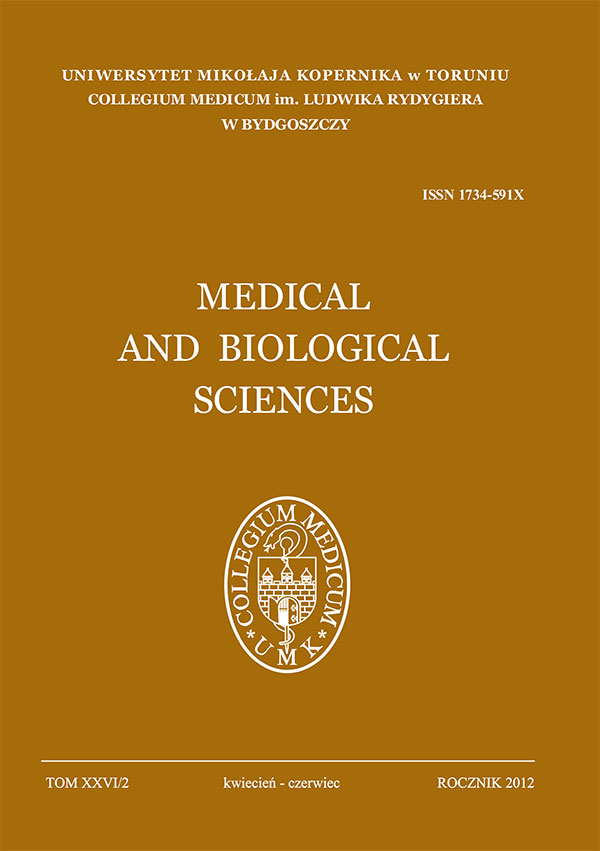Effect of a single dose of methadone on the functioning of visuo-spatial working memory in opiate dependent individuals with HIV(+) treated with methadone
DOI:
https://doi.org/10.12775/v10251-012-0028-4Keywords
opiates, methadone, TMT A, HIVAbstract
Introduction . Subclinical measurements of psychomotor functions are being used for assessment of mental functions by finding relations with these functions. This study aims to assess the influence of a therapeutic dose of methadone on psychomotor speed in HIV(+) and HIV(-) subjects treated in substitution therapy.
Materials and methods. 73 patients [32 HIV(-) and 41 HIV(+)]treated with methadone for an average of 54 months, were examined. The assessment was conducted twice: before and about 1.5 hours after the administration of a therapeutic dose of methadone. Trail Making Test A (TMT A) was completed. The test sheet was placed on a graphic tablet. Execution time was measured in both parts of the test.
Results. It was found that the average time of TMT A test completion before methadone administration in HIV(-) subjects is statically significantly shorter than in HIV(+) ones. However, after methadone administration psychomotor speed, measured by the TMT A test, is not statistically significantly different in HIV(-) subjects treated in substitution therapy as compared to HIV(+) individuals. Subjects with HIV (+) performed TMTA test statistically significantly faster after a single dose of methadone.
Conclusion. A therapeutic dose of methadone in subjects infected with HIV virus can have an effect on the improvement in psychomotor performance. Interactions of antiretroviral drugs and methadone can lead to changes in the concentration of methadone in the body influencing the regulation of psychomotor activity at the same time.
References
Anthony J. C., Warner L., Kessler R. Comparative epidemiology of dependence on tabacco, alcohol, controlled substances and inhalants: Basic findings from the National Comorbidity Survey. Experimental and Clinical Psychopharmacology 1994, 2(3), 244-68.
Teesson M., Hall W., Degenhardt L. Uzależnienia - Modele kliniczne i techniki terapeutyczne. GWP, Gdańsk, 2005.
Connor M., Christie MD. Opioid receptor signaling mechanisms. Clin.Exp. Pharmacol. Physiol. 1999, 26, 493-9.
Law P.Y., Wong Y.H., Loh H.H. Molecular mechanisms and regulationof opioid receptor signaling. Annu. Rev. Pharmacol. Toxicol. 2000, 40, 389–430.
Ross S., Peselow E. The neurobiology of addictive disorders. Clin Neuropharmacol. 2009, 269-76. http://www.ncbi.nlm.nih.gov/pubmed/19834992
Uziałło J. Biologiczne podstawy uzależnień. Narkomania. 2009, 2 (46), 20-24.
Koob G. Drug Addiction. Neurobiology of Disease. 2000, 7, 543-45.
Machoy-Mokrzyńska A., Borowiak K., Białecka M. Neuronalne i molekularne mechanizmy powstawania uzależnień. Roczniki Pomorskiej Akademii Medycznej w Szczecinie. 2007, 2 (53), 9-12.
Gorzelańczyk E. J., Laskowska I. Rola jąder podstawy w regulacji funkcji poznawczych. Neuropsychiatria i Neuropsychologia. 2009, 4 (1), 26-35.
Gorzelańczyk E. J. Neurologiczne źródła uzależnień – perspektywa ewolucyjna i kliniczna. Alkoholizm i Narkomania. 2011. 24 (3), 235-249
Gorzelańczyk E. J. Functional anatomy, physiology and clinique of bas. Neuroimaging for Clinicians – Combining Research and Practice. InTech. Chorwacja, 2011. http://www.ncbi.nlm.nih.gov/pubmed/16824546
Farrell M., Ward J., Mattick M. Methadone maintenance treatment in opioid dependance: a review. BMJ. 1994, 309, 997-1001, http://www.ncbi.nlm.nih.gov/pubmed/7916226
Reitan R.M. Validity of the Trail Making test as an indicator of organic brain damage. Perceptual and Motor Skills. 1958, 8, 271-276. http://www.ncbi.nlm.nih.gov/pubmed/18234166, http://www.ncbi.nlm.nih.gov/pubmed/15010091
Matarazzo J.D., et al. Psychometric and clinical testretest reliability of the Halstead Impairment Index in a sample of healthy, young, normal men. Journal of Nervous and Mental Disease. 1974, 158(1), 37-49. http://www.ncbi.nlm.nih.gov/pubmed/4836545
Veilleux J.C., et al. A review of opioid dependence treatment: pharmacological and psychosocial interventions to treat opioid addiction. Clin Psychol Rev. 2010, 30(2), 155-66. http://www.ncbi.nlm.nih.gov/pubmed/19926374
Connock M., et al. Methadone and buprenorphine for management of opioid dependence: a systematic review and economic evaluation. Health Technol Assess. 2007, 11, 1–171. http://www.ncbi.nlm.nih.gov/pubmed/17313907
Leonard-Sarmiento F.E., Elfakhani M., Boutros N.N. The motor evoked potential in AIDS and HAM/TSP, http://www.ncbi.nlm.nih.gov/pubmed/20069238 state of the evidence. Arq Neuropsiquiatr. 2009, 67 (4) , 1157-63. http://www.ncbi.nlm.nih.gov/pubmed/20069238
Habrat B., et al. Odstęp QT w zapisie ekg u osób z uzależnieniem opioidowym leczonych substytucyjnie. Alkoholizm i Narkomania. 2008, 21(3), 263-85.
Morgane P.J., Galler J.R., Mokler D.J. A review of systems and networks of the limbic forebrain/limbic midbrain. Prog Neurobiol. 2005, 75, 143-160. http://www.ncbi.nlm.nih.gov/pubmed/15784304
Altice F.L., Friedland G.H., Cooney E.L. Nevirapine induced opiate withdrawal amonginjection drug users with HIV infection receiving methadone. AIDS. 1999, 957-962. http://www.ncbi.nlm.nih.gov/pubmed/10371177, http://www.ncbi.nlm.nih.gov/pubmed/10371177
Cantilena L., McCrea J., Blazes D. Lack of a pharmacokinetic interaction between indinavirand methadone. Clin. Pharmacol. Ther. 1999, 65, 135-135
Clarke S.M., Mulcahy F.M., Tija J. The pharmacokinetics of methadone in HIV-positive patients receiving the non-nucleoside reverse transciptase inhibitor efavirenz. Br. J. Clin. Pharmacology. 2000, 51, 213-217.http://www.ncbi.nlm.nih.gov/pubmed/23653911
McDowell J.A., Chittick G.E., Pilati C., Stevens C. Pharmacokinetic interaction of abacavirand ethanol in human immunodeficiency virus-infected patients. Antimicrob. Agents Chemother. 2000, 44, 1686-1690.
Published
How to Cite
Issue
Section
Stats
Number of views and downloads: 0
Number of citations: 0



